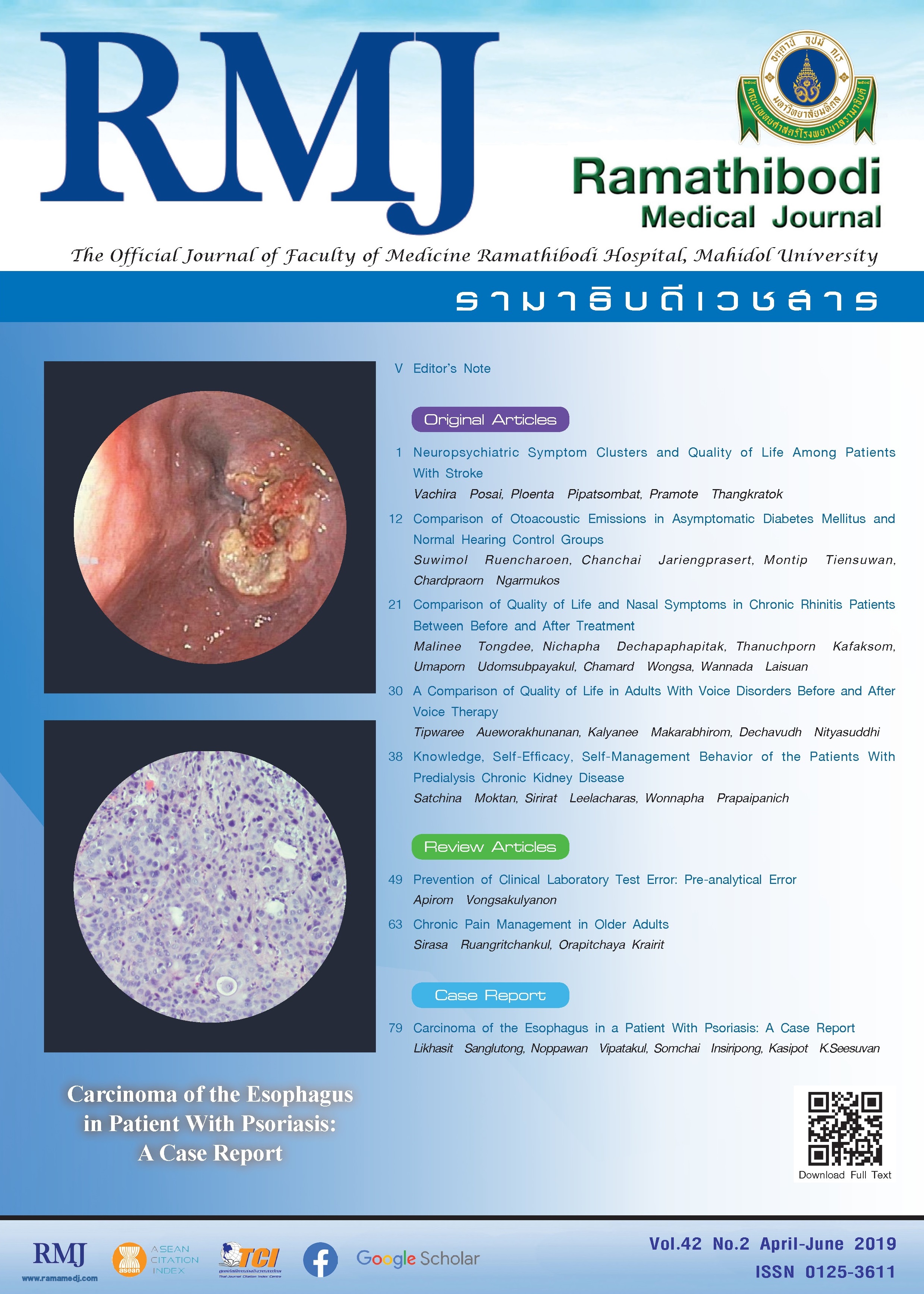A Comparison of Quality of Life in Adults With Voice Disorders Before and After Voice Therapy
DOI:
https://doi.org/10.33165/rmj.2019.42.2.102568Keywords:
Voice disorders, Voice therapy, Quality of lifeAbstract
Background: Previous studies have documented the effectiveness of voice therapy in terms of voice quality outcomes rather than quality of life outcomes.
Objective: To compare the quality of life among patients with voice disorders, before and after voice therapy.
Methods: Thirty-six patients with voice disorders who visited the Speech Clinic at Ramathibodi Hospital from March 2013 to January 2015 were enrolled. Thirty minutes per session within 10 weeks period of voice therapy program were used. The voice therapy approaches included direct and indirect therapy. The outcomes of this study were measured using Dr. Speech software version 5 for acoustic analysis and the Voice Handicap Index in Thai version for quality of life. Data was analyzed by descriptive and inferential statistics (Paired t test).
Results: The total participants were 36 patients with a mean age of 51.31 years. They were divided to 4 groups according to the causes of voice disorders that were 18 patients for structural cause, 8 patients for functional cause, 6 patients for neurological cause, and 4 patients for inflammatory cause. The results for both voice quality and quality of life after voice therapy improved and showed statistically significant differences (P < .05). The patients with all causes of voice disorders were statistically significant differences in total the Voice Handicap Index scores (P < .05). Moreover the structural causes group exhibited statistically significant differences in all subscales (P < .05) but the others causes groups were not statistically significant differences in emotional subscale for functional causes, physical subscale for neurological causes, and functional subscale for inflammatory cause (P > .05)
Conclusions: Voice therapy might be an effective treatment to decrease the severity of voice disorders in role of voice quality and quality of life, especially voice disorders from structural causes.
References
Aronson AE. Clinical voice disorders: an interdisciplinary approach. New York, NY: Thieme-Stratton; 1980.
Stemple JC, Glaze L, Gerdemann BK. Clinical voice pathology: Theory and management. 3rd ed. San Diego, CA: Singular Publishing Group; 2000.
Roth FP, Worthington CK. Treatment Resource Manual for Speech-Language Pathology. 2nd ed. Albany, NY: Singular Thomson Learning; 2001.
Rammage L, Morrison M, Nichol H. Management of the Voice and Its Disorders. 2nd ed. San Diego, CA: Singular Thomson Learning; 2001.
Makarabhirom K. The Study of the Effectiveness of Voice Therapy in Adult Patients With Vocal Nodules in Speech Clinic of the Ramathibodi Hospital [master’s thesis]. Bangkok, Thailand: Mahidol University; 1994.
Faculty of Medicine Ramathibodi Hospital. Patient statistics services (OPD & ER); 2015. http://wss.rama.mahidol.ac.th/sites/hospital/his/OPD/default.aspx. Accessed January 9, 2019.
Faculty of Medicine Ramathibodi Hospital. Patient statistics; 2002 - 2007. http://reportserver/Report Server?/OPD/PatCount/M_ETA/Opdtab2_ETA_Mn. Accessed January 9, 2019.
Colton RH, Casper JK, Leonard R. Understanding Voice Problems: A Physiological Perspective for Diagnosis and Treatment. 3rd ed. Philadelphia, PA: Lippincott Williams & Wilkins; 2006.
Carding PN, Horsley IA, Docherty GJ. A study of the effectiveness of voice therapy in the treatment of 45 patients with nonorganic dysphonia. J Voice. 1999;13(1):72-104. doi:10.1016/S0892-1997(99)80063-0.
Thomas LB. Stemple JC. Voice therapy: does science support the art? Comm Disord Rev. 2007;1(1):49-77.
Boone DR. The voice and voice therapy. 3rd ed. Englewood Cliffs, NJ: Prentice-Hall; 1983.
Pannbacker M. Half-swallow boom: does it really happen? Am J Speech Lang Pathol. 2001;10:17-18.
Cohen SM, Garrett CG. Utility of voice therapy in the management of vocal fold polyps and cysts. Otolaryngol Head Neck Surg. 2007;136(5):742-746. doi:10.1016/j.otohns.2006.12.009.
Jacobson BH, Johnson A, Grywalski C, et al. The voice handicap index (VHI): development and validation. Am J Speech Lang Pathol. 1997;6:66-70. doi:10.1044/1058-0360.0603.66.
Behlau M, Alves Dos Santos Lde M, Oliveira G. Cross-cultural adaptation and validation of the voice handicap index into Brazilian Portuguese. J Voice. 2011;25(3):354-359. doi:10.1016/j.jvoice.2009.09.007.
Taguchi A, Mise K, Nishikubo K, Hyodo M, Shiromoto O. Japanese version of voice handicap index for subjective evaluation of voice disorder. J Voice. 2012;26(5):668.e15-e.9. doi:10.1016/j.jvoice.2011.11.005.
Behrman A, Rutledge J, Hembree A, Sheridan S. Vocal hygiene education, voice production therapy, and the role of patient adherence: a treatment effectiveness study in women with phonotrauma. J Speech Lang Hear Res. 2008;51(2):350-366. doi:10.1044/1092-4388(2008/026).
Bowie L, Dey J, Long R. The client voice. Speech & Language Therapy in Practice. 2004;7-9.
Roy N, Gray SD, Simon M, Dove H, Corbin-Lewis K, Stemple JC. An evaluation of the effects of two treatment approaches for teachers with voice disorders: a prospective randomized clinical trial. J Speech Lang Hear Res. 2001;44(2):286-296. doi:10.1044/1092-4388(2001/023).
Thai Speech-Language and Hearing Association. Ethic of speech-language pathology and audiology. Khon Kaen, Thailand: Khon Kaen Printing; 2000.
Huang DZ. Voice Lab in Clinical Practice; 1998. http://www.drspeech.com/Papers.html. Accessed March 9, 2019.
Jaruchinda P, Suwanwarangkool T. Cross-cultural adaptation and validation of the voice handicap index into Thai. J Med Assoc Thai. 2015;98(12):1199-1208.
Speyer R, Wieneke GH, Dejonckere PH. Documentation of progress in voice therapy: perceptual, acoustic, and laryngostroboscopic findings pretherapy and posttherapy. J Voice. 2004;18(3):325-340. doi:10.1016/j.jvoice.2003.12.007.
Chen SH, Hsiao T, Hsiao L, Chung Y, Chiang S. Outcome of resonant voice therapy for female teachers with voice disorders: perceptual, physiological, acoustic, aerodynamic, and functional measurements. J Voice. 2007;21(4):415-425. doi:10.1016/j.jvoice.2006.02.001.
Speyer R. Effects of voice therapy: a systematic review. J Voice. 2008;22(5):565-580. doi:10.1016/j.jvoice.2006.10.005.
Amir O, Dukas M, Shnaps-Baum R. The effect of a ‘voice course’ on the voices of people with and without pathologies: Preliminary observations. Logoped Phoniatr Vocol. 2005;30(2):63-71. doi:10.1080/14015430500233229.

















